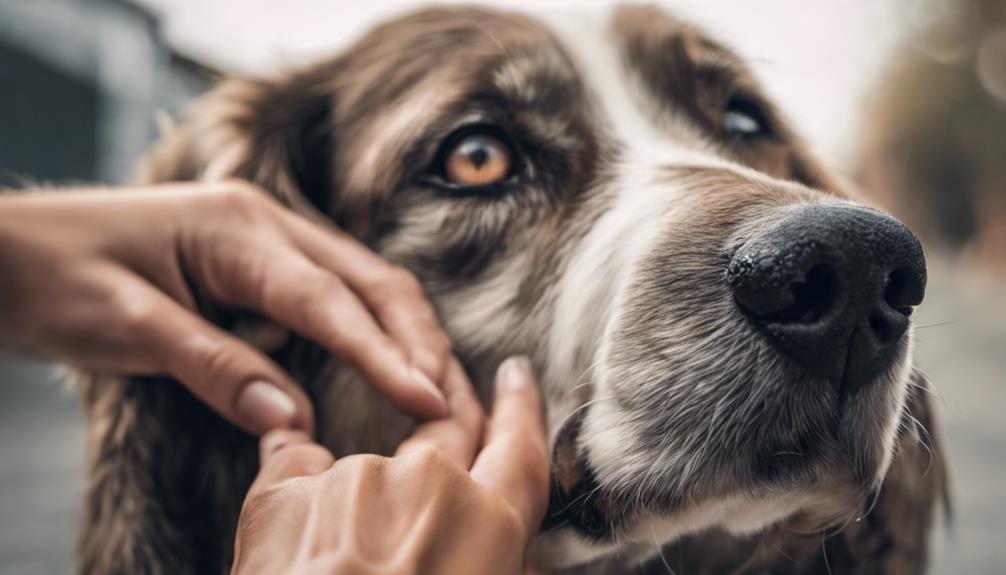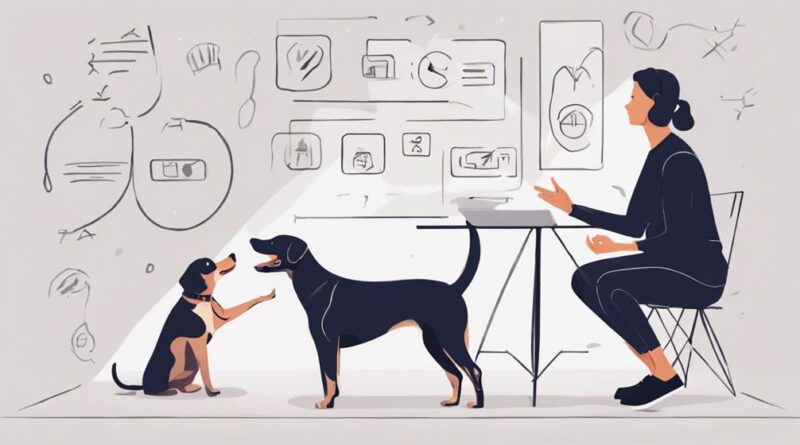Enhancing Canine Communication: Proven Techniques Explored
Did you know that dogs communicate through a combination of body language, vocalizations, and subtle cues? Understanding these signals is crucial for building a strong bond with your furry companion.
By implementing proven techniques such as active listening, positive reinforcement, and clear boundaries, you can enhance your canine communication skills significantly.
Stay tuned to discover practical strategies that will help you decipher your dog's messages more effectively and strengthen your relationship with them.
Understanding Canine Body Language
When observing your dog, pay attention to their ears, tail, and overall posture to understand their body language. Canine posture and signals play a crucial role in communication. For example, a dog standing tall with ears perked up and tail wagging gently indicates a sense of alertness or curiosity. On the other hand, a dog cowering with their tail between their legs and ears flat against their head may signify fear or submission.
Tail wagging is a common form of communication among dogs, but it's essential to consider the context and speed of the wag. A broad, slow wag often suggests a relaxed and friendly demeanor, while a stiff, rapid wag could indicate agitation or potential aggression. By interpreting these subtle cues in conjunction with their overall posture, you can gain valuable insights into your dog's emotions and intentions. Understanding these nuances in canine body language can strengthen your bond and improve your communication with your furry companion.
Practicing Active Listening With Dogs
To deepen your understanding of canine communication, actively listen to your dog's vocalizations and behaviors for valuable insights into their needs and emotions. Improving responsiveness in your furry companion starts with paying close attention to their barks, whines, growls, and body language.
By tuning in to these cues, you can better understand what your dog is trying to communicate, whether they're feeling anxious, excited, scared, or content. Building trust with your dog is crucial for a strong human-canine bond.
When you actively listen to your dog, you show them that their feelings and needs matter to you, which in turn fosters trust and a sense of security. Remember, communication is a two-way street, so be patient and open to learning from your dog.
Utilizing Positive Reinforcement Training
Engage with your dog using positive reinforcement techniques to encourage desired behaviors and strengthen your bond. Positive reinforcement training involves rewarding your pup for good behavior, which can lead to long-lasting results.
Here are some tips to make the most of this training approach:
- Clicker training: Using a clicker can help mark the exact moment your dog performs the desired behavior, making it easier for them to understand what they're being rewarded for.
- Consistency: Be consistent in your training methods and rewards. Dogs thrive on routine, so maintaining consistency will help them learn faster and reinforce positive behaviors effectively.
- Treat rewards, shaping behavior: Use high-value treats to reward your dog when they exhibit the behavior you desire. Additionally, shaping behavior involves breaking down complex actions into smaller steps, making it easier for your dog to learn and succeed.
Incorporating Play for Better Communication
Playing with your dog is a fun and effective way to enhance communication and strengthen your bond. By engaging in playtime activities, you can significantly improve engagement and foster connection with your furry friend. When you play with your dog, you aren't only having a good time together but also building a stronger relationship based on trust and understanding.
Incorporating interactive games like fetch, tug-of-war, or hide-and-seek can help boost your dog's engagement levels and create a deeper connection between the two of you. These activities encourage your dog to communicate with you through body language, vocalizations, and play behaviors, enhancing your ability to understand each other better.
Through play, you can also observe your dog's responses and preferences, allowing you to tailor your communication style to match their needs. This mutual interaction fosters a sense of companionship and companionship, making your bond with your dog even more meaningful. So, grab your dog's favorite toy and start playing to strengthen your communication and connection today.
Establishing Clear Boundaries and Expectations
When setting clear boundaries and expectations for your dog, consistency is key in reinforcing desired behaviors and fostering effective communication. By establishing these guidelines, you can ensure a harmonious relationship with your furry companion.
Here's how to successfully set boundaries and expectations for your dog:
- Consistent reinforcement: Make sure to reward your dog promptly when they exhibit the desired behavior. Consistency in rewarding good behavior helps your dog understand what's expected of them.
- Setting limits: Clearly define what behaviors are acceptable and unacceptable for your dog. Setting limits helps your dog distinguish right from wrong and promotes a structured environment.
- Regular training sessions: Schedule regular training sessions to practice commands and reinforce boundaries. Training sessions not only help your dog learn but also strengthen the bond between you and your furry friend.
Recognizing Vocal Cues in Dogs
To understand your dog better, pay attention to their vocal cues as they communicate various emotions and needs. Dogs use barking as a primary form of communication. By interpreting the pitch, duration, and intensity of their barks, you can gain insight into what they're trying to convey. For example, a sharp and repetitive bark may signal alertness or excitement, while a low and continuous bark could indicate fear or aggression. Understanding your dog's barking patterns will help you respond appropriately to their needs.
Whining is another vocal cue that dogs use to communicate. Whether it's a high-pitched whimper or a prolonged moan, whining can express a range of emotions such as anxiety, pain, or seeking attention. Pay attention to the context in which your dog is whining to better understand what they're trying to tell you. By recognizing and responding to your dog's whining, you can strengthen your bond and improve communication with them.
Developing a Strong Bond Through Interaction

Building a strong bond with your dog is crucial for fostering a healthy relationship based on trust and understanding. To strengthen your connection with your furry friend, consider the following tips:
- Quality Time Together: Spend dedicated one-on-one time with your dog engaging in activities they enjoy, such as playing fetch, going for walks, or simply cuddling on the couch. This helps build trust and reinforces your bond.
- Positive Reinforcement: Use positive reinforcement techniques like treats, praise, and gentle petting to reward good behavior. This encourages your dog to trust you and strengthens the bond between you.
- Communication: Pay attention to your dog's body language, vocalizations, and behavior to better understand their needs and emotions. Responding appropriately shows your dog that you're attentive and caring, further fostering a deep connection.
Fine-Tuning Nonverbal Signals With Dogs
To enhance your communication with your canine companion, attune yourself to their subtle nonverbal cues and signals. Dogs communicate primarily through body language, so understanding their nonverbal cues is crucial for effective interaction. Pay attention to their posture, tail wagging, ear position, and facial expressions to grasp their feelings and intentions. For example, a relaxed posture with a gently wagging tail indicates a happy and friendly demeanor, while a stiff body and raised fur may signal fear or aggression.
Communication strategies with dogs involve mirroring their behavior to establish a connection. Reflecting their energy level and mimicking their body language can help build trust and rapport. Additionally, using consistent hand signals alongside verbal commands can reinforce understanding and obedience. Remember to always maintain a calm and assertive demeanor to convey leadership and establish boundaries.
Fine-tuning your ability to interpret and respond to your dog's nonverbal cues will deepen your bond and foster clear communication. By actively engaging with your canine companion through attentive observation and appropriate responses, you can strengthen your relationship and ensure harmonious interactions.
Frequently Asked Questions
Can Dogs Communicate With Each Other Through Scent and Pheromones?
Yes, dogs can communicate with each other through scent and pheromones. Scent recognition and pheromone signals play a vital role in canine olfactory communication techniques. Their keen sense of smell allows them to convey information, emotions, and even establish social hierarchies.
How Can a Dog's Past Experiences Affect Their Communication Style?
Your dog's past experiences, including trauma effects, can significantly impact their communication style. Behavioral patterns developed from previous situations can shape how they interact with others.
Understanding these influences can help you communicate effectively with your furry friend. By recognizing and respecting your dog's history, you can build a stronger bond and create a safe environment for them to express themselves.
This awareness can lead to better communication and a deeper connection with your canine companion.
Are There Specific Breeds That Are More Communicative Than Others?
Certain breeds exhibit varying levels of communicativeness. For example, some breeds, like the Siberian Husky or the Beagle, are known for being more vocal and expressive through howling or barking.
On the other hand, breeds such as the Basenji are less vocal and rely more on body language to communicate.
These breed differences in communication styles highlight the importance of understanding both canine body language and vocalizations for effective communication with your furry friend.
Can a Dog's Age Impact Their Ability to Communicate Effectively?
As dogs age, their communication abilities can change. Age-related changes might impact how effectively they convey their needs and emotions.
Just like humans, dogs go through stages of canine development that can influence their communication skills. Understanding these changes can help you better interpret your furry friend's signals and strengthen your bond.
Paying attention to your dog's behavior as they age is key to maintaining clear and effective communication.
How Can Environmental Factors Influence a Dog's Communication With Humans?
Influence from environmental factors significantly impacts a dog's communication with humans. Canine behavior is shaped by surroundings, affecting how they interact and convey needs.
Communication barriers may arise if a dog lacks socialization effects in various environments. Exposure to diverse settings can enhance communication skills, making it easier for dogs to express themselves effectively.
Understanding how the environment impacts communication is crucial for fostering strong human-canine relationships.
Conclusion
By implementing these proven techniques, you can greatly enhance your communication with your canine companion. Understanding their body language, listening actively, using positive reinforcement, incorporating play, setting boundaries, recognizing vocal cues, and strengthening your bond through interaction will all contribute to a deeper connection with your furry friend.
Fine-tuning your nonverbal signals will further improve your ability to communicate effectively with your dog. Start practicing these techniques today to strengthen your relationship with your beloved pet.
